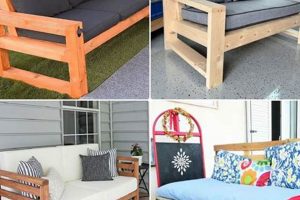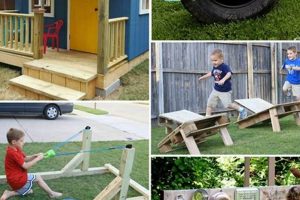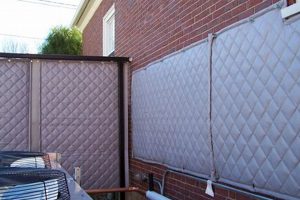Safeguarding exterior seating pads through do-it-yourself methods involves implementing strategies and techniques to shield cushions from environmental damage. This includes utilizing various materials and processes to enhance resistance to moisture, sunlight, and general wear and tear. For example, applying a water-repellent spray, constructing protective covers, or choosing specific fabrics known for their durability are all considered part of this approach.
The significance of these protective measures lies in their ability to extend the lifespan of outdoor furnishings and minimize the need for frequent replacements. This results in long-term cost savings and reduces environmental impact by decreasing textile waste. Historically, individuals have employed methods such as storing cushions indoors during inclement weather or using natural oils to treat fabrics, highlighting a continued desire to preserve these items.
Subsequent discussion will delve into specific methods and materials suitable for shielding exterior seating pads from the elements. Topics covered will include the selection of appropriate fabric treatments, techniques for creating custom covers, and practical storage solutions to optimize the longevity of these furnishings.
Guidance for Preserving Exterior Seating Pads
Effective preservation of exterior seating pads requires careful consideration and implementation of protective measures. The following points provide actionable guidance for extending the lifespan and maintaining the aesthetic appeal of outdoor cushions.
Tip 1: Fabric Selection: When acquiring or replacing outdoor cushions, prioritize fabrics specifically designed for exterior use. These materials typically exhibit enhanced resistance to UV radiation, moisture, and mildew. Examples include solution-dyed acrylic and olefin fabrics.
Tip 2: Water-Repellent Treatments: Application of a specialized water-repellent spray creates a barrier against moisture penetration. Reapplication should occur regularly, following manufacturer instructions, particularly after cleaning or prolonged exposure to rainfall.
Tip 3: Custom Protective Covers: Fabricating custom covers offers an additional layer of defense against the elements. Utilize breathable, water-resistant materials such as polyester canvas or specialized outdoor fabrics. Ensure a snug fit to prevent wind displacement and water accumulation.
Tip 4: Strategic Storage Practices: During periods of inclement weather or non-use, storing cushions indoors or in a designated weatherproof container is essential. This minimizes exposure to moisture, UV radiation, and environmental pollutants, significantly extending their lifespan.
Tip 5: Regular Cleaning Protocols: Implement a consistent cleaning schedule to remove dirt, debris, and potential mildew growth. Utilize a mild soap solution and a soft brush or cloth. Ensure thorough drying before storage or reuse to prevent moisture-related damage.
Tip 6: Cushion Rotation: Periodic rotation of cushions promotes even wear and tear, preventing localized fading or degradation. This simple practice can contribute to a more uniform appearance and prolonged lifespan.
Tip 7: Drainage Enhancement: If cushions tend to retain water, consider adding drainage holes to the cushion construction or utilizing cushion inserts designed with drainage properties. This facilitates water expulsion and reduces the risk of mildew formation.
Consistent application of these strategies provides effective means for protecting exterior seating pads, preserving their appearance, and maximizing their utility over extended periods. The cumulative effect of these measures contributes significantly to minimizing replacement costs and maintaining the overall aesthetic of outdoor living spaces.
Following sections will explore detailed instructions on creating custom covers and addressing specific challenges related to outdoor cushion maintenance.
1. Fabric impermeability
Fabric impermeability serves as a cornerstone of effective exterior cushion preservation. As a component within a broader strategy of DIY cushion protection, its primary function is to impede water penetration, thereby preventing moisture-related damage. In the absence of fabric impermeability, cushions become susceptible to waterlogging, leading to the proliferation of mildew, material degradation, and compromised structural integrity. For example, a cushion exposed to rainfall without any level of water resistance will quickly absorb moisture, creating an environment conducive to mold growth and eventual disintegration of the internal padding. This connection between water absorption and cushion deterioration underscores the vital role of impermeability.
Various methods exist to achieve fabric impermeability, ranging from selecting inherently water-resistant materials such as solution-dyed acrylics or coated polyesters, to applying topical water-repellent treatments. The choice of method depends on factors such as budget, aesthetic preferences, and the intended level of protection. Application of a durable water repellent (DWR) coating, for instance, creates a barrier that causes water to bead up and roll off the fabric surface. However, the effectiveness of DWR coatings diminishes over time and necessitates reapplication to maintain optimal performance. The practical significance of this understanding lies in the ability to make informed decisions regarding fabric selection and protective treatments, tailored to the specific environmental conditions and usage patterns.
Ultimately, the attainment of fabric impermeability is a proactive measure that yields significant long-term benefits in cushion preservation. Addressing this aspect minimizes the need for frequent cushion replacements and contributes to the overall aesthetic appeal and longevity of outdoor living spaces. Challenges may arise in maintaining impermeability over time, requiring periodic reapplication of treatments and diligent cleaning practices to remove dirt and debris that can compromise water resistance. Recognizing and addressing these challenges is crucial for ensuring sustained protection and maximizing the return on investment in outdoor furnishings.
2. UV radiation defense
Ultraviolet (UV) radiation poses a significant threat to the integrity and appearance of exterior seating pads. Prolonged exposure to UV rays causes degradation of fabric fibers, leading to fading, embrittlement, and a reduced lifespan. Within the context of do-it-yourself cushion protection, implementing effective UV radiation defense mechanisms constitutes a crucial component. The connection is causal: UV radiation exposure causes damage, and effective defense mitigates this damage. For example, cushions left unprotected under direct sunlight for extended periods will exhibit noticeable fading and weakening of the fabric within a single season. This degradation not only detracts from the aesthetic appeal but also compromises the structural integrity of the cushion, rendering it more susceptible to tearing and wear. The practical significance of understanding this relationship lies in the ability to proactively select materials and apply treatments that offer superior UV resistance.
Strategies for UV radiation defense include the selection of inherently UV-resistant fabrics, such as solution-dyed acrylics, which incorporate UV-blocking pigments directly into the fiber during manufacturing. These fabrics retain their color and structural integrity for longer periods compared to conventionally dyed materials. Additionally, the application of UV-protective sprays or coatings provides an extra layer of defense. These treatments contain UV absorbers that effectively neutralize the harmful effects of radiation. Implementing shading solutions, such as awnings or umbrellas, further reduces the direct exposure of cushions to sunlight. The effectiveness of these measures can be observed in the sustained vibrant color and structural soundness of cushions protected using these techniques, compared to the rapid deterioration seen in unprotected cushions exposed to identical environmental conditions. Moreover, consistent rotation of cushions minimizes localized UV exposure, promoting uniform wear and prolonging the overall lifespan.
In summary, UV radiation defense is an indispensable element of any comprehensive DIY strategy for protecting exterior seating pads. Addressing this factor proactively through appropriate material selection, treatments, and shading solutions mitigates the damaging effects of UV radiation, thereby extending the lifespan, preserving the aesthetic appeal, and reducing the need for frequent replacements. While challenges may arise in maintaining consistent UV protection over extended periods and in varying environmental conditions, the long-term benefits of implementing these measures far outweigh the initial investment in time and resources. This approach contributes to both cost savings and environmental sustainability by minimizing textile waste and maximizing the usable life of outdoor furnishings.
3. Mildew resistance
Mildew resistance represents a critical aspect of safeguarding exterior seating pads through do-it-yourself methodologies. The presence of mildew not only compromises the aesthetic appeal of cushions but also accelerates material degradation, leading to premature failure. Effective mildew resistance minimizes the need for frequent cleaning or replacement, thus extending the serviceable life of outdoor furnishings. The relationship is straightforward: susceptible cushions foster mildew growth, while resistant measures inhibit it. For example, cushions left untreated in humid environments often develop visible mildew colonies, resulting in staining and a musty odor. Conversely, cushions treated with mildew-inhibiting agents or constructed from inherently resistant materials remain free from such infestations, preserving their appearance and structural integrity.
Strategies for enhancing mildew resistance encompass various material selection and treatment approaches. The use of fabrics treated with antimicrobial agents directly impedes mildew growth. Proper ventilation and drainage also reduce moisture accumulation, diminishing the conditions conducive to mildew proliferation. Moreover, regular cleaning protocols employing appropriate cleaning solutions remove organic matter that serves as a nutrient source for mildew. As an illustrative instance, specialized marine-grade vinyl exhibits inherent mildew resistance due to its non-porous composition and antimicrobial additives. Its utilization in cushion construction provides a formidable barrier against mildew infestation in humid or damp environments.
In summary, mildew resistance is an indispensable component of a comprehensive do-it-yourself strategy for safeguarding exterior seating pads. Its implementation minimizes material degradation, extends the lifespan of cushions, and preserves aesthetic appeal. Though consistent maintenance and vigilance are required to ensure sustained mildew protection, the benefits far outweigh the effort. The adoption of these measures contributes to cost savings, reduces environmental impact, and maintains the comfort and usability of outdoor living spaces.
4. Seam reinforcement
Seam reinforcement plays a pivotal role in protecting outdoor cushions via do-it-yourself methods. These are often the points of greatest stress and vulnerability, and their failure can compromise the entire cushion’s structural integrity and weather resistance. Strengthening these areas is essential to prolong cushion lifespan and maintain aesthetic appeal.
- Thread Selection
The choice of thread significantly impacts seam durability. Polyester or nylon threads, known for their strength and resistance to UV degradation and mildew, are superior choices for outdoor applications compared to cotton threads, which are more susceptible to environmental damage. Improper thread selection can lead to seam failure and water intrusion into the cushion’s interior.
- Stitch Density and Type
Increasing the stitch density (stitches per inch) strengthens the seam by distributing stress over a larger area. A lockstitch, which secures each stitch independently, prevents unraveling should one stitch break. Using a higher stitch density and the appropriate stitch type enhances the seam’s resistance to tearing and water penetration.
- Seam Construction Techniques
Employing techniques such as flat-felled seams, which encase the raw edges of the fabric within the seam, provides added protection against fraying and water intrusion. Reinforcing seams with binding or edge tape also strengthens the seam and provides a barrier against moisture. Proper seam construction contributes significantly to the cushion’s overall weather resistance and longevity.
- Reinforcement at Stress Points
Areas such as zippers, corners, and tie attachments experience higher levels of stress. Reinforcing these points with additional stitching, fabric patches, or metal hardware distributes the load and prevents seam failure. Neglecting to reinforce these stress points can lead to premature wear and tear and eventual seam rupture.
These facets demonstrate the critical importance of seam reinforcement in protecting outdoor cushions. By carefully considering thread selection, stitch density and type, seam construction techniques, and reinforcement at stress points, individuals can significantly enhance the durability and weather resistance of their outdoor cushions, thereby prolonging their lifespan and preserving their aesthetic appeal. Proper execution of these DIY methods contributes directly to both cost savings and environmental sustainability by minimizing the need for frequent cushion replacements.
5. Strategic Covering
Strategic covering constitutes a crucial component of protecting exterior seating pads through do-it-yourself methodologies. The practice involves the judicious application of protective barriers to shield cushions from environmental elements, thereby extending their lifespan and preserving their aesthetic qualities. This approach recognizes the causal relationship between exposure to adverse conditions and accelerated degradation of cushion materials. For example, unprotected cushions left exposed to rainfall, direct sunlight, or accumulated debris experience accelerated fading, mildew growth, and structural damage compared to those that are strategically covered. The importance of this stems from the understanding that consistent protection minimizes wear and tear, thus reducing the frequency of replacement and associated costs.
Effective strategic covering practices encompass several key considerations. The selection of appropriate covering materials, such as water-resistant and UV-protective fabrics, is paramount. Custom-fitted covers provide a snug fit, preventing wind displacement and minimizing exposure to moisture and debris. The implementation of a consistent covering schedule, particularly during periods of inclement weather or non-use, is essential for maintaining optimal protection. For example, cushions covered with breathable, water-resistant tarpaulins during extended periods of rain or snowfall exhibit significantly less moisture absorption and mildew growth than uncovered cushions. Similarly, employing UV-resistant covers during peak sunlight hours mitigates fading and fabric degradation. The practical application extends to tailoring cover designs to accommodate varying cushion shapes and sizes, ensuring comprehensive coverage and preventing water accumulation in recessed areas.
In conclusion, strategic covering is an indispensable element of a comprehensive DIY strategy for protecting exterior seating pads. By implementing a proactive and consistent approach to covering, individuals can significantly reduce the environmental impact on their outdoor furnishings, thereby extending their lifespan, preserving their aesthetic appeal, and minimizing the need for frequent replacements. The long-term benefits of strategic covering, including cost savings and reduced waste, underscore its importance as a sustainable and practical approach to outdoor cushion maintenance.
Frequently Asked Questions
This section addresses common inquiries regarding do-it-yourself methods for safeguarding exterior seating pads, providing clarity on best practices and addressing potential challenges.
Question 1: What fabrics offer the most inherent protection against the elements without requiring additional treatments?
Solution-dyed acrylic fabrics and marine-grade vinyl exhibit superior resistance to UV radiation, water damage, and mildew growth, minimizing the need for supplementary protective measures. These materials maintain colorfastness and structural integrity for extended periods, even under prolonged exposure to harsh environmental conditions.
Question 2: How frequently should water-repellent treatments be reapplied to maintain adequate protection?
Reapplication frequency depends on the specific treatment and the level of environmental exposure. Generally, reapplying after each cleaning cycle or following prolonged periods of heavy rainfall is recommended. Consult the manufacturer’s instructions for specific guidance.
Question 3: What are the drawbacks of using plastic tarpaulins as cushion covers?
While plastic tarpaulins provide waterproof protection, they lack breathability, potentially trapping moisture and promoting mildew growth. Furthermore, they offer limited UV protection and can become brittle and prone to tearing under prolonged exposure to sunlight.
Question 4: Is it necessary to store cushions indoors during the winter months, even if they are covered?
Storing cushions indoors during winter is advisable, regardless of covering. Indoor storage minimizes exposure to prolonged freezing temperatures, snow, and ice, which can damage fabric fibers, compromise structural integrity, and accelerate mildew growth.
Question 5: What cleaning solutions are most effective for removing mildew without damaging the fabric?
A diluted solution of mild dish soap and water is generally effective for removing mildew. For more stubborn stains, a solution of oxygen bleach can be used, but it is essential to test the solution on an inconspicuous area first to ensure it does not cause discoloration or damage. Avoid using harsh chemicals or abrasive cleaners, as these can degrade fabric fibers.
Question 6: How can seam strength be improved when creating custom cushion covers?
Utilize high-quality polyester or nylon thread, increase stitch density, and employ a lockstitch to prevent unraveling. Reinforce seams at stress points, such as zippers and corners, with additional stitching or fabric patches. Flat-felled seams provide enhanced protection against fraying and water intrusion.
These answers provide guidance to common concerns regarding protecting outdoor cushions using DIY methods. By understanding these aspects and applying the corresponding strategies, individuals can maintain the quality and lifespan of their outdoor furnishings.
The subsequent section delves into specific challenges encountered in extreme weather conditions and provides targeted solutions for enhanced cushion protection.
Conclusion
The preceding exploration of protecting outdoor cushions DIY underscored the multifaceted nature of effective preservation. Emphasis was placed on fabric selection, water-repellent treatments, strategic covering, UV radiation defense, mildew resistance, and seam reinforcement as critical elements in extending cushion lifespan and maintaining aesthetic integrity. The adoption of these do-it-yourself strategies mitigates environmental damage and minimizes the need for frequent replacements.
Consistent application of the outlined protective measures provides tangible benefits in terms of cost savings and reduced environmental impact. While challenges may arise in maintaining sustained protection, the proactive implementation of these techniques ensures long-term value and reinforces the importance of diligent stewardship in preserving outdoor living spaces. Prioritizing these methods allows for the continued enjoyment of outdoor furnishings, while minimizing resource consumption and promoting sustainable practices.







